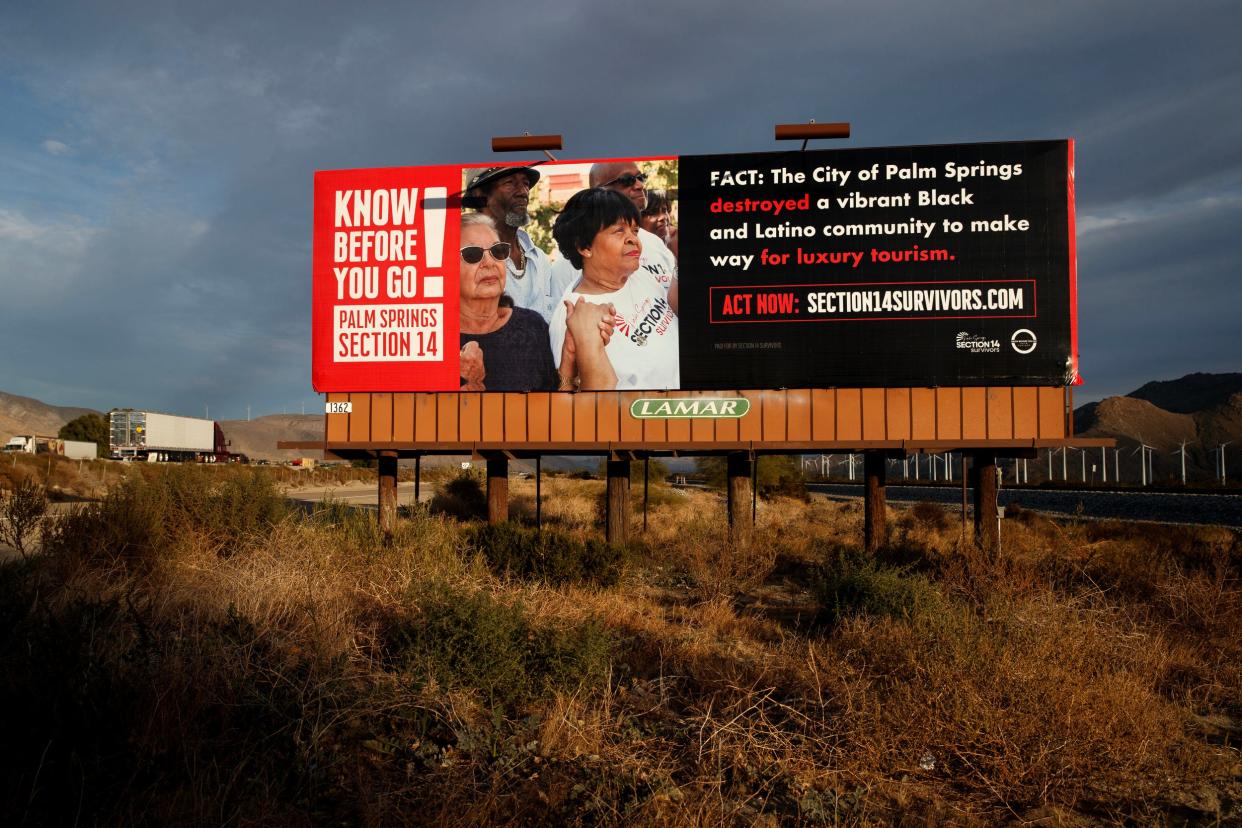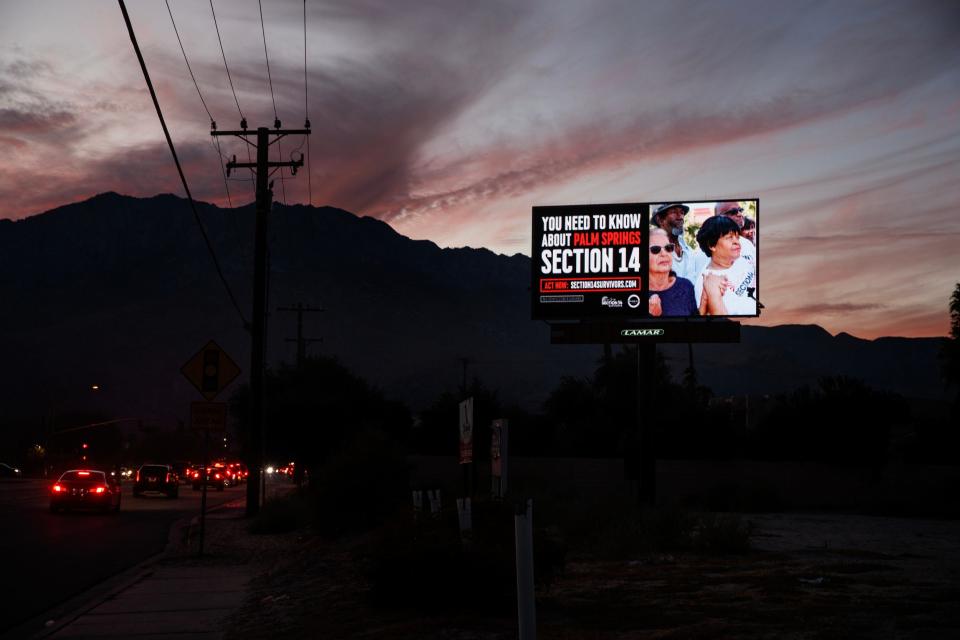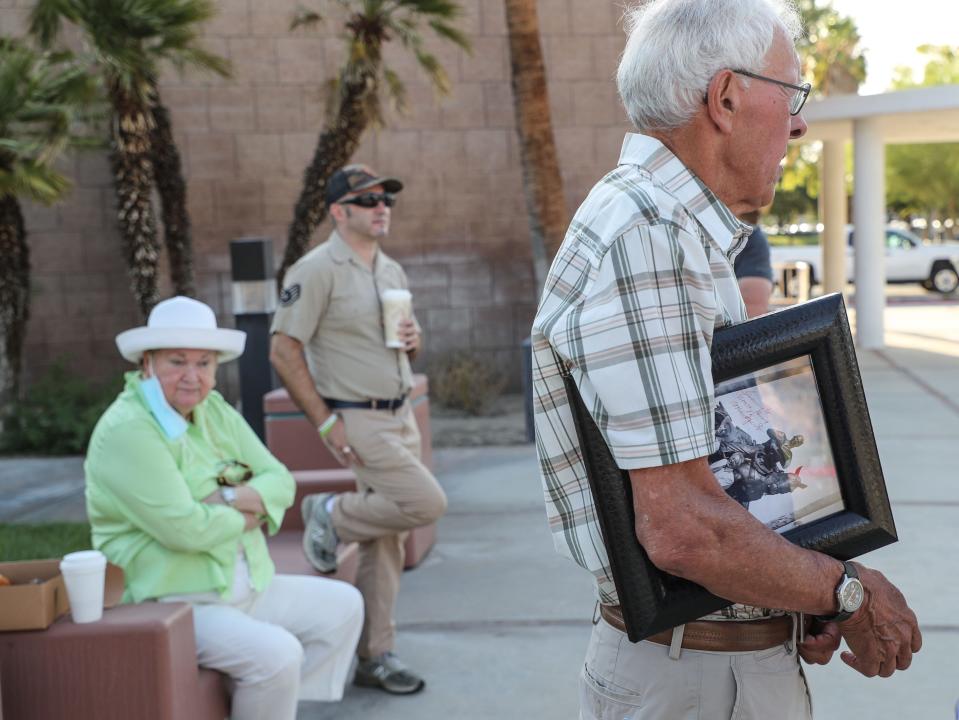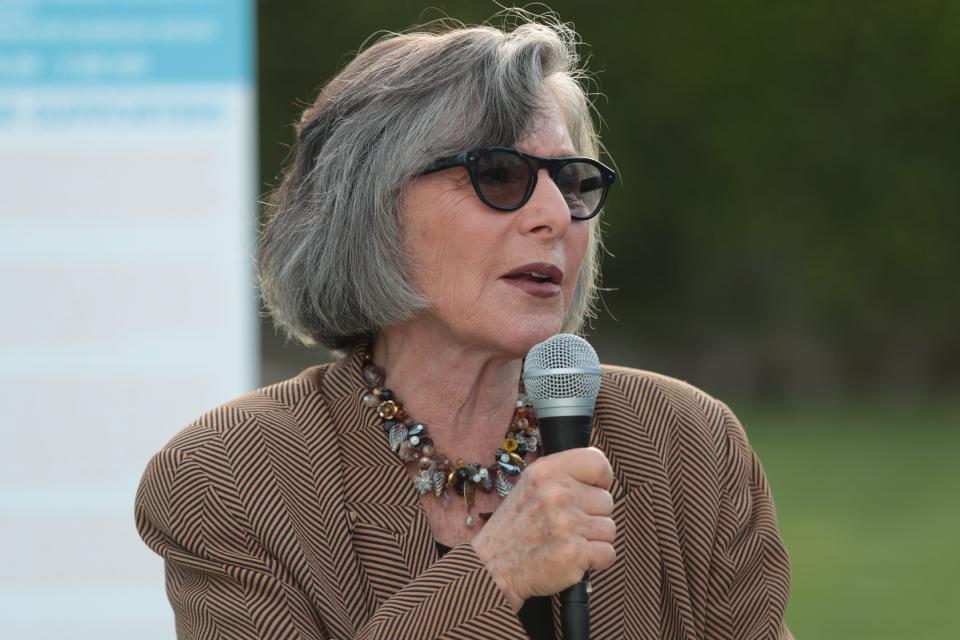In latest in bid for reparations, Section 14 group turns to billboards, Barbara Boxer

- Oops!Something went wrong.Please try again later.
The group pushing the city of Palm Springs to pay reparations to people whose homes they say were wrongly destroyed by the city in the 1960s is employing two new tactics in its fight: billboards along two major roadways and help from former U.S. Sen. Barbara Boxer.
Boxer, a Rancho Mirage resident, told The Desert Sun she had joined the campaign and is looking to provide ideas on how to support the group.
And earlier this month, two billboards funded by the Section 14 Survivors group and emblazoned with messages aimed at generating support for the reparations campaign were installed along the interstate near the eastern and western entries to the city. A third was installed along Ramon Road east of Gene Autry Trail.
Large text on one of the billboards reads “FACT: The city of Palm Springs destroyed a vibrant Black and Latino community to make way for luxury tourism.“ Another includes a quote it attributes to an unnamed Section 14 survivor: “We smelled the smoke, we watched the houses burn.” The third reads simply: “You need to know about Palm Springs Section 14.”
The billboards have generated varied reactions, including from the city itself, which has said that the billboards and the larger campaign are part of an effort aimed at discouraging tourism to Palm Springs.
Complicated history: What is Section 14?
Section 14 is a 1-square-mile area of land belonging to the Agua Caliente Band of Cahuilla Indians. For decades, it was home to many people of color, who either rented or built their own homes on land that was either formally or informally leased because racist housing policies denied them the ability to buy homes elsewhere in the city.
During the 1950s and 1960s the residents were removed from their homes, which were demolished and sometimes burned down, and the tribe began redeveloping the land after a federal change in policy was enacted allowing Native American tribes to lease their land for long periods of time, which they had not been able to do previously.
However, many of the circumstances surrounding the clearing and redevelopment of Section 14 — and who was responsible for it — remain disputed to this day by different parties in the city.
In a claim for damages filed against the city in 2022, the Section 14 Survivors group alleges the process amounted to “racially motivated attacks.” The claim also alleges that the city participated in and oversaw the destruction of the homes without proper notice to residents in what constituted an unlawful and immoral taking of their homes.
Others, including some former city leaders, have disputed many aspects of the narrative presented in the claim, saying that the city itself did not decide to remove the people from the land or participate in the eviction process, which was ordered and carried about by several other entities, including Riverside County and its health department, the Bureau of Indian Affairs and the tribe itself. They have said the city was involved in demolishing and burning a small number of homes at the direction of the tribe, but did so only after receiving confirmation that those who lived in the homes had been served eviction notices.
Much of the debate has focused on a 1968 report written by California Deputy Attorney General Loren Miller about the removal of the residents. The reported concluded that "there is no evidence that any crimes were committed in the removal of the residents from Section 14 and the destruction of their homes."
However, the report also stated that "the incident displayed a unique insensitivity on the part of the city of Palm Springs to the problem of adequate minority housing" and asserted that the city had approached the conservators appointed to oversee the tribe's finances with a plan to raze Section 14. Some critics have argued that pivotal aspects of the report have since been disproven by records released by the city, including an assertion that the city kept no official records of the persons displaced and residences destroyed.
The pending claim filed last year also estimated the harm caused by the city to be "upwards to $2 billion" and stated that the city should pay damages, although it did not specify an amount sought.
The group's attorney, Areva Martin, told The Desert Sun that its current focus is on re-opening discussions "with the city with the shared goal of reaching a reasonable, fair, and just solution that will help the survivors and their descendants recover what was taken from them and honor the history and contributions of this important community."
"We see plenty of ways to get to a win-win here, both for the survivors and the city," Martin said.
What’s the goal of the billboards?

All three of the new billboards also include photos of living survivors and text stating “Act Now: Section14survivors.com.” That website includes a link to a “Stand with the Section 14 Survivors and Descendants” petition. As of Friday, 1,761 people had signed the petition, which states “ensuring that reparations are made is the is the very least we can do to begin to right the wrongs.”
The website also includes information about Palm Springs Section 14 Survivors Inc., a new IRS-recognized nonprofit formed by the group that describes its mission as being “to seek justice for the harm done and to be a vehicle of support to help improve the overall quality of life for the survivors and descendants of Section 14 Housing and Community Destruction.”
There is also a webpage with links to various platforms for making donations to the nonprofit (a GoFundMe had raised $1,190 as of last week).
A statement on one portion of the website summarizes the events as “families relegated to a one-mile-square neighborhood because of racist restrictive covenants, who then built a thriving community, only to have it torn from them in a shocking, coordinated effort to burn their homes and belongings and unlawfully seize their property.” There is also a section recounting the personal experiences and recollections of six people who once lived on Section 14.
One of them is Pearl Devers, the nonprofit group's chair, who said it paid for the billboards with donations.
Martin, the group's attorney and a national political commentator and activist, said the billboards represent the latest step in an effort to “really elevate this story.”
“Our efforts are working,” Martin said. “People are asking about it, they’re visiting the website, we’re getting folks engaged around this history which for decades has been buried.”
The billboards are part of the “Know Before You Go” campaign the group launched in October, which is aimed at educating tourists and seasonal residents about Section 14 and garnering their support for its effort.
But why target visitors, given that the decision about whether to provide reparations lies with the city council, which is elected by and accountable to full-time residents, not tourists and part-timers?
Martin said it’s because the council is cognizant of the millions that pour into the city from tourists and seasonal residents, which means those groups collectively hold power that can be used to pressure the city.
“I would think that every decision the city council makes is consistent with trying to maintain, if not grow, the number of visitors and the dollars that are spent (in Palm Springs),” she said.
Asked if that means the group wants people to avoid visiting Palm Springs if the city does not compensate those with ties to Section 14, Martin said, “I think that’s up to the city.”
However, she said members of the group "love this city and they want what is in the best interest of this city," noting they've made settlement proposals that include new cultural and racial healing centers that would, among other goals, generate revenue for the city.
“If people decide not to come to Palm Springs, it’s not going to be because of actions on the part of the survivors and descendants,” she said. “It’s going to be because of actions on the part of the city council.”
City calls billboards an attack on tourism
That perspective, however, is not shared by the city, which issued a statement criticizing the billboards for trying to discourage tourism.
“It is difficult to see how Ms. Martin and her clients believe that their content on their billboards will help the City of Palm Springs," city spokesperson Amy Blaisdell said in the statement. "The 'Know Before You Go' campaign looks more like an attempt to discourage visitors from coming to Palm Springs than anything."
Blaisdell concluded by saying, "The City Council continues to be interested in collaborating with residents and stakeholders on programs and initiatives that will make an impact on the lives of those displaced from Section 14.”
The Desert Sun asked residents on social media to weigh in on the billboards. One respondent said the billboards would draw more attention to the truth of Section 14. Others, however, said the billboards did not portray the full complexity of the issue and don't make clear that Section 14 was cleared decades ago.
"These billboards seem to imply this happened recently," said Craig Rushing, who also said he was "all for awareness of Section 14."
Susie Griffin Bridgeman expressed a similar concern.
"I do not want to whitewash history, but it is also important to understand the (nuances) of the situation and the reality of what the solutions can and should be," Bridgeman said.
The Desert Sun also asked Doug Evans and Norm King, two of the leaders of the Friends of Frank Bogert, about the billboards. That's the organization that unsuccessfully worked to keep a statue at city hall of the late Bogert, who was mayor during much of the Section 14 removal process. His legacy has been disputed as people debate his level of involvement in the evictions and demolitions, and in 2021 the city council voted to remove the statue.
Evans and King said they did not have a specific comment on the billboards. However, they said members of the group Section 14 Survivors continue to misrepresent key elements of what happened, despite their claims being disproven by information the pro-Bogert group has brought to light. They called on the city to follow through on a public commitment it made last year to produce a factual record of what occurred with Section 14 as a precondition to any agreement to reparations.
"If they don't do that, they're going to have a very difficult time with their citizens relative to potentially a gift of public funds," said Evans, who is also a former Palm Springs city planner. "The threshold to write checks to individuals is very high, so they have to put a record together."

King, a former Palm Springs city manager, said the group was absolutely confident that its position would be upheld if the city completed such a process.
Evans added that the city council erred in 2021 when it issued an apology for the city's role in the removals and pledged to provide reparations. He said it has since become clear the city raised expectations when it didn't have the facts right and is now in a bind as a result.
He also said that the Section 14 campaign's PR efforts have repeatedly cited false or exaggerated information, such as when Martin said at an event earlier this year that 5,000 Black and brown people were violently evicted from Section 14 by the city. Evans said that there were never 5,000 Black and brown people living on Section 14 and the city itself did not evict a single person.
"Public relations need to stick a little closer to the facts if you're going to try to convince the community to do something substantial," Evans said. "Hyperbole doesn't work in the public arena, and it really is difficult if that is the type of thing that's being said."
Despite PR successes, settlement talks stall
The launch of the billboard campaign comes after a year in which Martin has said she worked hard to put Section 14 and her group’s quest for compensation in front of a national audience — and often succeeded.
In the past year, outlets including ABC News, The Guardian, The Associated Press and local publications in places as far flung as Hawaii and Atlanta have run stories about the issue, usually with a framing that was largely sympathetic or supportive of the group's cause. The issue has also received particular attention in the large Los Angeles media market.
But it also comes after a year in which little or no progress was made on advancing the group’s aims at city hall.
The council has repeatedly discussed the legal claim with the city attorney behind closed doors, but has had no public discussions of the issues since April. That's when it voted 3-2 not to hire a Columbia University-affiliated group to lead a process that would’ve been aimed at designing a reparations program. Those in the majority on that vote said they weren't opposed to reparations, but wanted objective historical facts before deciding whether or how to design any compensation program.
In November, Martin told The Desert Sun that she and her group had grown increasingly frustrated with the lack of serious good faith offers coming from the city to resolve the claim, even as her clients have made proposals about how to do so.
But as it looks forward to 2024, she says the billboards are just the start of what is planned to be an expanded public relations campaign, that she says will include everything from more billboards to lawn signs to education events.
“We want to shout this story from every rooftop possible,” she said. “We wanted to have the largest possible platform. And so we started with these billboards, but we hope that this becomes a much, much larger campaign.”
Former senator lending voice, ideas

As it looks to further spread its message and put pressure on the city in the coming year, the group will also have the help of Boxer, one of the most well-known political figures in the entire state.
Earlier this month, Boxer told The Desert Sun that she had recently joined the group’s effort to raise awareness about Section 14, which she called an opportunity for Palm Springs “to be in a leadership place when it comes to taking care of economic injustice.”
Boxer, who represented California in the U.S. Senate from 1993 to 2017 and now lives in Rancho Mirage, told The Desert Sun those who lived on Section 14 should be compensated just as a bicyclist would need to be compensated if she hit them while driving a car and wrecked their bike.
“If I go, 'Oh, I am so sorry, have a nice day' and then I go home, that’s not right,'” she said. “I need to pay you back. I need to make restitution; I need to make reimbursement. To me, it’s as simple as that, but it's a lot more than a bike; it's a lot more than a car. It's a home.”
Boxer said she is excited to work on the campaign. She said the city council is made up of good people and "I honestly think they have an opportunity to meet here, I think we can make it work here and just tell the truth about what happened and how we're going to tailor this in a narrow way to make sure the survivors get what they are owed and the descendants also have more opportunity.”

When asked if she would be interested in sitting down with the council, Boxer said she did not know and is currently focused on serving as an “idea machine,” working with the group to “see if I can give some ideas there that will go over with the rest of the council.” She said working to identify ideas for fixing problems was central to her role in passing legislation during her career.
“Here we have a situation where we can fix this thing,” she said. “We can make it happen. I'm very hopeful that working together, we can get the other council people on board. I'm very hopeful.”
In response to an inquiry to Palm Springs Mayor Jeffrey Bernstein, Blaisdell provided a statement saying the city had not been contacted by Boxer but could be open to working with her.
"If her involvement represents a move away from the litigation threats that Ms. Martin has previously made, and more toward a collaborative approach as originally proposed by the city, then the city welcomes Senator Boxer’s involvement," she said.
Devers, who has said she and her parents moved their family to several homes on Section 14 when she was a child trying to escape the demolitions, said Boxer’s was the latest example of good people coming to the former residents’ aid as they learn about what is happening.
To Martin, meanwhile, Boxer’s voice is a testament to how far the campaign has come.
“When I came into this community, I was saddened really by how disenfranchised many of the survivors and descendants felt…” she said. “And when I look at, from our first activation to what we just accomplished in October with our justice rally, and now to have Senator Boxer champion the cause, it says that we've made a tremendous amount of progress.”
Paul Albani-Burgio covers breaking news and the city of Palm Springs. Follow him on Twitter at @albaniburgiop and email him at paul.albani-burgio@desertsun.com.
This article originally appeared on Palm Springs Desert Sun: Can Barbara Boxer help win Section 14 reparations from Palm Springs?

